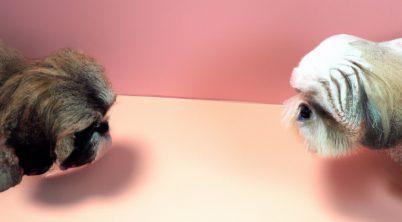Pekingese dogs, a breed cherished for their unique appearance, face an increased risk of developing certain health issues due to their distinctive physical traits. Among the most concerning of these health problems is the potential for blindness. The breed’s characteristic flat face and large eyes not only contribute to its appealing look but also predispose Pekingese dogs to a range of eye conditions. One such condition is brachycephalic ocular syndrome, a disorder inherently linked to the physical structure of brachycephalic, or “short-nosed,” breeds like the Pekingese.
Given their particular anatomy, Pekingese may experience various ophthalmic issues that can lead to vision impairment or outright blindness. The development of such conditions may be gradual, or in some instances, acute, where rapid intervention could be critical, as in the case of an eyeball prolapse. Recognizing the symptoms early in their onset is paramount for pet owners to seek prompt and effective veterinary care.
While some eye problems may lead to temporary discomfort, others can have far-reaching consequences for the dog’s quality of life. Therefore, gaining an understanding of the health challenges associated with the Pekingese breed, especially concerning their vision, is essential for owners to ensure the welfare and happiness of their pets.
Table of Contents
Understanding Pekingese and Their Vision
The Pekingese breed, known for its distinctive face shape, is predisposed to several eye conditions that can affect their vision. Understanding the genetic and breed-specific risks can help owners and breeders in managing and possibly preventing vision loss in Pekingese dogs.
Genetics and Health Problems
The genetics of the Pekingese breed predispose these dogs to several health problems related to their eyes. Breeders aware of these risks can take steps to minimize the occurrence of inheritable eye conditions. Many of the vision issues in Pekingese are associated with their genetic background, characterized by a particular head and eye structure.
Brachycephalic Ocular Syndrome
Brachycephalic Ocular Syndrome (BOS) is prevalent among Pekingese due to their brachycephalic head shape. Conditions grouped under BOS, such as corneal ulcers and exposure keratopathy, stem from their prominent eyes and short muzzles, often leading to:
- Irritation: The shape of the dog’s face can cause constant discomfort and pain.
- Corneal Issues: Their shallow eye sockets can result in ulcers and abrasions.
Surgical treatments can alleviate but may also introduce distress and the potential for repeated operations.
Progressive Retinal Atrophy
Progressive Retinal Atrophy (PRA) is another genetic disorder that affects Pekingese, characterized by the gradual deterioration of the retina, which can lead to blindness. This condition is:
- Hereditary: Passed down genetically, affecting the breed’s long-term vision health.
- Irreversible: No cure exists; however, understanding the hereditary nature helps breeders make informed decisions about breeding practices to avoid propagation.
Signs and Symptoms of Vision Loss
When a Pekingese begins to lose its vision, they may exhibit distinct behavioral changes and physical indicators. Caregivers should be alert to these signs, as early detection can be crucial for treatment and adaptation.
Behavioral Changes
- Increased caution or hesitation: They may move more slowly or seem hesitant, particularly in unfamiliar environments.
- Bumping into furniture or walls: As their senses adjust to the loss of sight, they might misjudge distances and bump into objects in their path.
- Reluctance to use stairs or jump from heights: Without clear vision, these activities become more daunting, and they may avoid them altogether.
Physical Indicators
- Redness in the eyes: Red, bloodshot eyes can be a symptom of underlying eye problems that could lead to vision loss.
- Pawing at eyes or visible pain: They might show discomfort by scratching at their eyes or exhibit signs of pain such as squinting or tearing.
- Change in eye appearance: Look for any haziness or cloudiness in their eyes, which could indicate cataracts or other eye issues affecting their vision.
Diagnosis and Treatment Options
When a Pekingese presents symptoms of potential vision impairment, it is crucial they receive a proper diagnosis to determine the cause and extent of the condition. Effective treatment options range from medical interventions to surgical procedures, depending on the severity and underlying cause of the blindness.
Veterinary Examination
A comprehensive veterinary checkup is the first step in diagnosing eye problems in a Pekingese. Veterinarians will conduct a thorough eye examination, which may include procedures such as:
- Slit-lamp biomicroscopy: To examine the structures of the eye in detail.
- Tonometry: To measure intraocular pressure, checking for glaucoma.
- Ophthalmoscopy: To view the back of the eye, including the retina.
- Schirmer tear test: To assess tear production and identify dry eye syndrome.
These diagnostic tests help identify conditions like pigmentary keratitis, cataracts, or progressive retinal atrophy, which can lead to blindness if left untreated.
Medical Intervention
Following diagnosis, veterinarians may prescribe medication to manage the condition or address secondary infections. Potential medical treatments include:
- Anti-inflammatory drugs: To reduce inflammation and discomfort.
- Antibiotics: If an infection is present.
- Topical treatments: Such as eyedrops or ointments to alleviate dry eye or corneal ulcers.
In cases where chronic conditions like pigmentary keratitis are diagnosed, ongoing medication may be necessary to control the progression of the disease.
Surgical Procedures
For certain health problems, surgery may be the recommended course of action. Surgical interventions can include:
- Phacoemulsification: To remove cataracts and restore vision.
- Keratectomy: For severe cases of pigmentary keratitis where vision is significantly obstructed by corneal pigmentation.
- Reconstructive surgeries: To correct anatomical deformities contributing to eye conditions.
A veterinarian will determine if a Pekingese is a candidate for surgery based on their overall health, age, and the likelihood of improving their quality of life.
Caring for a Blind Pekingese
Caring for a blind Pekingese requires specific changes to the home environment and the maintenance of a stable routine. These adaptations are crucial to ensure the safety and well-being of the dog.
Home Adaptations
Creating a safe space for a blind Pekingese is paramount. Owners should:
- Remove hazards: Keep floors clear of objects that could cause injury.
- Use textures: Place different textures on the floor to help the Pekingese differentiate between rooms.
- Maintain layout: Keep furniture in the same location to prevent confusion.
Application of safety measures:
| Area | Action item |
|---|---|
| Stairs | Install baby gates to prevent falls. |
| Sharp corners | Cushion with padding to avoid injuries. |
| Hazardous objects | Relocate or secure items that could harm. |
Routine and Consistency
A consistent routine is vital for a blind Pekingese’s sense of security. They should have:
- Regular feeding times: Stick to a strict schedule to help them anticipate meal times.
- Consistent grooming: Regular grooming sessions help monitor their health and prevent skin issues.
Daily structure:
| Activity | Time | Notes |
|---|---|---|
| Feeding | 7 AM / 6 PM | Two meals a day at the same spot. |
| Walks | 8 AM / 7 PM | Short walks in familiar, safe areas. |
| Playtime | After walks | Use scented toys or audible cues for interaction. |
| Grooming | Weekly | Check for any signs of infections or irritations. |
Maintaining such a routine helps a blind Pekingese thrive despite their lack of sight, allowing them to navigate their world with confidence.
Breeding and Prevention Strategies
To mitigate vision loss in Pekingese dogs, strategic steps can be taken in the realms of genetic health screening and responsible breeding practices.
Screening for Genetic Health
Screening for genetic health involves testing the breeding Pekingese dogs for inheritable conditions that could lead to blindness. Health issues such as Progressive Retinal Atrophy (PRA), which Pekingese may be prone to, can be identified through DNA tests. Prospective parents should be screened before breeding to ensure they do not carry genes that could increase the likelihood of health problems in their offspring.
- Genetic Tests Offered:
- DNA testing for PRA
- Ocular examination by a certified veterinary ophthalmologist
Responsible Breeding Practices
Responsible breeding practices are critical for reducing the incidence of health issues, including those leading to blindness in Pekingese. Breeders should:
- Select mating pairs with clear genetic test results to minimize the risk of hereditary diseases.
- Avoid breeding individuals with extreme brachycephalic features, as this exacerbates the risk of Brachycephalic Ocular Syndrome.
- Follow breeding guidelines laid out by canine health organizations and breed clubs.
- Key Aspects of Responsible Breeding:
- Mating selection based on health and temperament
- Limiting the number of litters for a breeding female
- Proper care and socialization of puppies before adoption
By implementing these strategies, breeders aim to produce healthy Pekingese that are less likely to suffer from blindness and other genetic predispositions.








